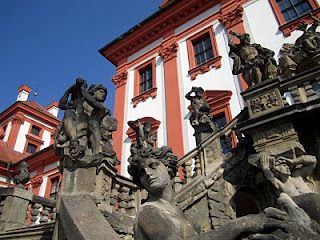
After the one hour drive, we were split into several groups. My group was lead by the Art & Architecture of Prague course professor, so it was nice to meet her and learn from her even before our course begins next week. The city is in a picturesque valley, and the picture below shows me in front of the large gothic St. Barbara Cathedral in the historical center. I know there's more pictures than text in this blog post, but there really was so much to see in the Czech Republic this weekend!

The program provided us lunch at a traditional czech pub. Nothing like chicken, potatoes, mushroom soup, bread, and, of course, beer to send you into a food coma for the rest of the day.

While in Kutná Hora, we took a guided tour of some of the silver mines. The tour guide only spoke minimal English, so we really had to pay attention and watch our surroundings. Over 100 feet below the surface of the ground, we walked the the criss-cross of networks to learn more about the terribly difficult life on a miner in the Czech Republic. The silver at once made this region prosperous and took a toll on the local population.

Perhaps the most fascinating part of Kutná Hora is the infamous Bone Chapel. That's right, the entire little church is decorated with the remains of 50,000+ victims of the Black Plague and Holy Wars. In order to make room for the massive amount of burials at this time, old bodies were dug up to make room for new ones. Make sure you click the picture above for a full-sized view!

The Bone Chapel is the work of a half-blind monk. Clearly, you'd have to be blind to not see how creepy this place would be. The concept of bone churches began in England and eventually spread to the rest of Europe. It was very difficult for me to find peace in this kind of space, knowing so many dead people's remains were surrounding me.

On Sunday, my Art & Architecture of Prague teacher took us to Troja Castle in the outskirts of Prague. This mansion was built in the 17th century in the pattern of the French Royal Palace of Versailles. It has many different types of style and architecture. And of course, there was a wine festival on the grounds this weekend too.

Above is the Great Room, which is the handiwork of two Dutch Jews who were paid to decorate this ornate residence. There are even parts of the Christian motif that have Hebrew in them, as the artisans were inserting their heritage into their work. We ended the day at the Old New Synagogue in the Josefov section of Prague. The former Jewish quarter is the home to the oldest surviving synagogue in all of Europe. The place is very small but ornate, lasting over 700 years through persecution, Holocaust, and communism.

It's back to the daily grind of Czech class here in Prague. We have a few planned activities at school this week, including an extracurricular expo and academic meetings with our professors. i will also be signing up for a few required weekend trips around the Czech Republic for our courses, in addition to my optional trip to Krakow, Poland. I'm very excited to be traveling around Central Europe this semester, and I will keep you posted as to where I decide to continue my adventures!
No comments:
Post a Comment